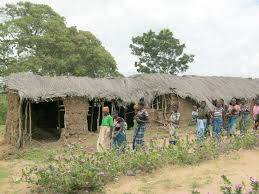
On a beautiful bright Monday, just under 10 minutes before midday we were on a tarmac road in Zomba.
We travelled from Mangochi to Zomba for some 6 hours, including two 30 minutes stops because the driver requested a rest in between.

Going up in Zomba district, we saw how surrounding communities have faced the rage of Namilambe River. It has been like this for many years: washing away their farmlands, dwelling houses and properties downstream.
For Joseph Marikebu, who lives in the populous village of Kankhomba in the district, this is every year’s burden that being one of affected without better dwelling house and food alternatives entails.
Due to high population growth, rapid deforestation, and widespread soil erosion, Kankhomba’s agricultural-based economy is particularly susceptible to climate change’s negative consequences.
“Every year, rainfall water washes away my maize farmland, due to this I fail to provide food for my family married with nine children,” he stated: “Trees are disappearing so fast that the few remaining, fails to control running water and powerlessly we witness our fields and properties being washed away.”
During the interview, the 58 year old and his two children of ages 13 and 9 years were gasping for air and sweating profusely as they rested in a shade of fast-disappearing natural trees.
In the year 2017, with support of World Food Programme (WFP) and cooperating partner World Vision Malawi, communities were drilled how to control the flow of water from hills and harvest it.
They were also taught how to conserve the environment by planting trees on the hills and along the river banks.
Malikebu further explains: “We are group of farmers who are called ‘community champions’, our role is to dig deep trenches, build dams and plant vetiver grass – a type of hedge with strong roots that prevents erosion of the land that controls water speed and stop it from flooding fields.”
“In the late 1970s, government planted trees for fuel wood in nearly all hills surrounding the mountain. Today, the hills lie bare. Now that the trees have vanished, the question is: How does the city assist the affected communities?” asked Zomba City Council chief executive officer Dyson Jangiya.
“Mount Zomba is under siege,” he said. “Zomba used to pride itself as a green city. Not anymore. Trees have disappeared at an alarming rate. Forests are vanishing at a faster rate than they are being refilled,” says Jangiya.
Zomba City Council wants to take control of the extensively deforested mountain which exposes residents to flash floods and landslides.
Effects of Climate Change
UNICEF (2013) report indicates that flood conditions, especially in the south of the country results in food insecurity with significant impacts on the livelihoods of poor people in rural areas.
More than 15 per cent of the population was affected by floods in the 2012/13 rainy season. In addition to floods, in the last few decades Malawi has experienced drought during 1991/92 and 1993/4.
According to USAID food assistance fact sheet of February 19, 2019 – the Malawi Vulnerability Assessment Committee estimates that 3.3 million Malawians, including nearly 1.8 million in the southern region, will require humanitarian food assistance during the October-to-March lean season—when food stocks are typically at their lowest.














